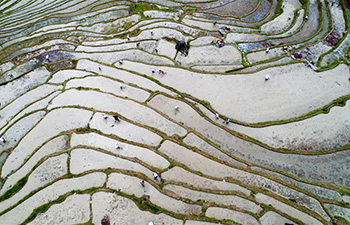WASHINGTON, May 2 (Xinhua) -- Chinese and Australian scientists found that the bamboo-eating giant pandas are more of a carnivore than a herbivore in terms of their nutrient intake.
The study published on Thursday in the journal Current Biology showed that the protein and carbohydrate content of the panda's plant diet looks much like that of a hypercarnivore or animals that obtain more than 70 percent of their diet from other animals.
About 50 percent of the panda's energy intake comes in the form of protein, placing them alongside feral cats and wolves, according to the study.
"Based on what they eat, they absolutely belong to the herbivores, but considering the macronutrient composition of the ingested and absorbed diets, they belong to the carnivores," said the paper's co-author Wei Fuwen, a zoologist with the Chinese Academy of Sciences.
The pandas have many traits similar with grass-eating herbivores, including the skull, jaw muscle and teeth that are adapted for fiber diets, and a specialized "pseudo-thumb" used for handling bamboo. They also lost the ability to taste umami, often associated with meat eating, according to the study.
However, giant pandas have a digestive tract, digestive enzymes and gut microbes that more resemble those of carnivores than herbivores.
Wei and David Raubenheimer, a nutritional ecologist from the University of Sydney, examined the macronutrient composition of the panda's diet.
Their team found that the mix that giant pandas both eat and absorb is similar to carnivores and the composition of the panda's milk also places it squarely among other carnivores.
They concluded that the evolution of the giant panda is more superficial than it was assumed, with substantial adaptation to new food types but relatively smaller changes in macronutrient handling.
The findings suggested that minimal evolutionary modification from panda's ancestral state was needed to deal with the macronutritional properties of bamboo.
The panda's short gut allows the panda to consume and process large amounts of bamboo, compensating for the low digestive efficiency of such a fibrous diet, according to the study.













